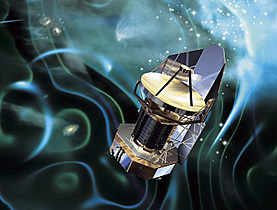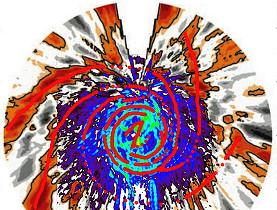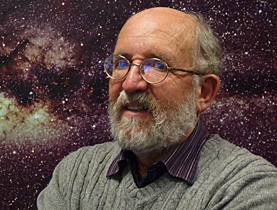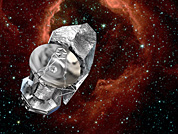Herschel telescope starts its star trek

Powerful space telescope Herschel – a European project with Swiss participation – is to boldly go where no space telescope has gone before.
Scientists hope that the instrument, which has just been launched into the cosmos from French Guiana, will help increase our understanding of how planets are formed and how the universe works.
After several delays over the past months, Herschel and its sister telescope Planck finally blasted off from the Kourou spaceport on board the Ariane 5 launcher on at 1:12pm UTC (10:12am local time) on May 14.
The European Space Agency (Esa) probes are being sent out to a position 1.5 million kilometres from the earth, to the so-called L2 Lagrange point, which is the best place from which to observe the cold universe.
The Herschel telescope, whose primary mirror is 3.5 metres in diameter, is four times bigger than any previous infrared space telescope.
It will collect long-wavelength infrared radiation from some of the coolest and most distant objects in the universe.
“It is the largest mirror that has ever flown in space,” said Arnold Benz, a professor of astronomy at the Federal Institute of Technology in Zurich, ahead of the launch.
New window
Scientists have never been able to study this type of long-wave infrared radiation before. For Benz, the experiment will be like opening “a new window”, especially as the Herschel telescope will allow observations of unprecedented detail.
“Basically we are going to explore the early phase of star, planet and galaxy formation, in our galaxy, a few hundred light years away, and in the early universe” Benz told swissinfo.ch.
“This will help us understand the origin, evolution and development of our own solar system, including the sun, planets, moons, comets and everything else,” he added.
Infrared radiation, or heat or thermal radiation, is invisible to the human eye. Even cold objects emit it, which means that infrared telescopes can observe cooler astronomical bodies that remain hidden from normal optical telescopes. They can also see objects covered by clouds of dust.
However, as the earth’s atmosphere blocks most infrared wavelengths from reaching the ground, these experiments need to be done from space.
Swiss contributions
Benz and a team of scientists were keen to contribute to the Herschel mission.
“As a long term specialist in spectrometers we offered our expertise in building this kind of instrument which can distinguish between different wavelengths,” Benz said.
Scientists have also been working on software that will analyse the data. In addition, they have developed observation programmes which should help them interpret the results. “This is the scientific part, which is of course, closest to my heart,” Benz said.
The Herschel telescope will also look for water. Water is needed for life, but it is also important in the formation of stars and planets. Dwarf planets like Pluto are mostly composed of frozen water.
“This water molecule is very abundant in star forming regions,” Benz explained. “Water acts as a kind of glue when these cosmic dust grains stick together, so we think water is worth studying even before life appears.”
Huge European project
Herschel and Planck – which will study what happened after the Big Bang – were produced as part of a joint Esa programme and have taken more than ten years to develop.
They are the most expensive equipment ever launched by Europe, at a total estimated cost of €1.9 billion (SFr2.9 billion).
The experiments are expected to take up to four years to complete, but data analysis could take much longer.
Benz himself attended the launch – his first ever. The professor has been fascinated by the cosmos since he was a boy, making rockets in his garden. For him, space really is the “final frontier”.
“That’s the way it works in astronomy. You’re not trying to do something a little better than before, but it’s always something entirely new or at least an order of magnitude better than before,” he explained.
“This is what pushes astronomy ahead so rapidly and why we have exciting new discoveries.”
Isobel Leybold-Johnson in Zurich, swissinfo.ch
The Planck experiment will research an even more elemental question than the Herschel. It will explore the cosmic background radiation that arose around 370,000 years after the Big Bang.
Swiss aerospace company Oerlikon was a leading contributor in the development and construction of the telescope. Planck’s telescope structure originated in Zurich.
Planck’s detectors are very sensitive and have to be kept at cold temperatures – close to absolute zero (Herschel also has to be cooled). Oerlikon has built special supports and protective shields which should help keep the Planck cool.
The dual launch will also be the first occasion on which the new horizontal separation system HSS-3 in the Ariane payload fairing, developed by Oerlikon, will be used.
The mission is named after the German physicist Max Planck, whose work on the behaviour of radiation won the Nobel Prize in 1918. Herschel comes from the German-British astronomer Frederick William Herschel who discovered infrared in 1800.
The Swiss Herschel contribution is a joint project of the Institute for Astronomy and the Microwave Electronics Laboratory at the Swiss Federal Institute of Technology in Zurich.
Also involved were the University of Applied Sciences in Northwestern Switzerland (software development), as well as Oerlikon Space, Ruag Aerospace and Baumer Electric.
Money is contributed to the Esa, but most of it comes back to Switzerland. Some funds are set apart for instrumentation and are divided 50:50 between universities and industry. Universities develop the prototypes and industry produces and tests the hardware.
Switzerland is contributing €94.4 million (SFr142.7 million) to Esa’s 2009 budget (3.35% of the total).

In compliance with the JTI standards
More: SWI swissinfo.ch certified by the Journalism Trust Initiative






You can find an overview of ongoing debates with our journalists here . Please join us!
If you want to start a conversation about a topic raised in this article or want to report factual errors, email us at english@swissinfo.ch.